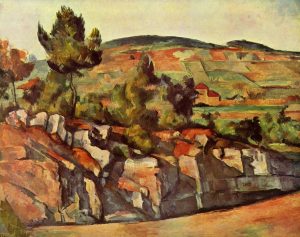Card Players by French Artist Paul Cezanne
This oil painting depicts three men (Card Players) with hats.
Château Noir by French Artist Paul Cézanne
After settling in Aix, France, in 1899, Cézanne ventured daily into the surrounding Provencal landscape in search of subjects to paint. Chateau Noir, a recently constructed neo-Gothic castle designed to mimic aged ruins, captivated him. He repeatedly represented this structure and also painted from its grounds, where he had an unobstructed view of nearby Mont Sainte-Victoire, another favoured subject. As is typical of landscapes executed late in his career, Cézanne applied thick paint in broad, multihued swatches.
La Mer à l’Estaque (The Sea at L’Estaque) by French Artist Paul Cézanne
Cezanne produced ‘The Sea at L’Estaque’ in 1878 whilst visiting the fishing village L’Estaque near Marseille in Southern France. Cezanne produced the painting outside allowing him to focus on the Mediterranean landscape first-hand.
La Route en Provence by French Artist Paul Cézanne
Madame Cézanne with Green Hat by French Artist Paul Cézanne
Cézanne painted at least 29 portraits of his wife, Marie-Hortense Fiquet. Here she appears in a green upholstered chair with her forearm resting on the chair’s elongated arm. Although she is fashionably dressed, Marie-Hortense leans at a seemingly uncomfortable angle and presents a stern expression to the viewer. The thrust-out lower lip and blank stare contrast with her whimsical hat; its transparent brim reveals her forehead underneat.
Self Portrait by French Artist Paul Cézanne
Still Life with Apples and a Pot of Primroses by French Artist Paul Cézanne
Cézanne rarely painted flowering plants or fresh-cut bouquets, which were susceptible to wilting under his protracted gaze. He included potted plants only in three still lifes, two views of the conservatory at Jas de Bouffan, his family’s estate, and about a dozen exquisite watercolors made over the course of two decades (from about 1878 to 1906). Cézanne seems to have reserved this particular table, with its scalloped apron and distinctive bowed legs, for three of his finest still lifes of the 1890s.This painting was once owned by the ardent gardener Claude Monet.
Still Life with Teapot by French Artist Paul Cézanne
Still Life with Teapot was painted towards the end of Cézanne’s life, thought to be between 1902 and 1906. It was painted at his studio in Aix-en-Provence and the table on which the objects are arranged still survives at the studio. A cloth is draped over the table, arranged carefully in elaborate but carefully arranged folds. On the cloth is a sugar bowl and a plate on which four fruit have been placed. On an uncovered section of the table, to the right of the painting, rests a teapot, knife and a further two fruit. The strong colours of the vessels, fruit and cloth are set against a washed-out green-grey background.
The Card Players French Artist Paul Cézanne
The Card Players by Paul Cézanne is one in a series of five oil paintings by the French Post-Impressionist artist painted during Cézanne’s final periods in the early 1890s.
This version is composed of four figures, featuring three card players at the forefront, seated at a table, with one spectator behind. Cézanne added the spectator and the pipes on the wall to give depth to the painting.
There is tension in the way the various players are contrasted by color, light and shadow, the shape of hats, and the clothing all representing confrontation through opposites. Cézanne’s created many preparatory works for the Card Players paintings, which indicates his commitment to this series of pictures.
Rather than posing his players in group playing cards, Cézanne made studies of them individually and only brought them together in his paintings. Many different farm workers came to sit for him throughout this project, often smoking their clay pipes.
Cézanne experimented with his compositions, striving to express the essence of these farmworkers and their traditional card game. This project resulted in five closely related paintings of different sizes showing men seated at a rustic table playing cards. One version of The Card Players was sold in 2011 to the Royal Family of Qatar for a price variously estimated at over $250 million, making it the third or fourth most expensive work of art ever sold.










